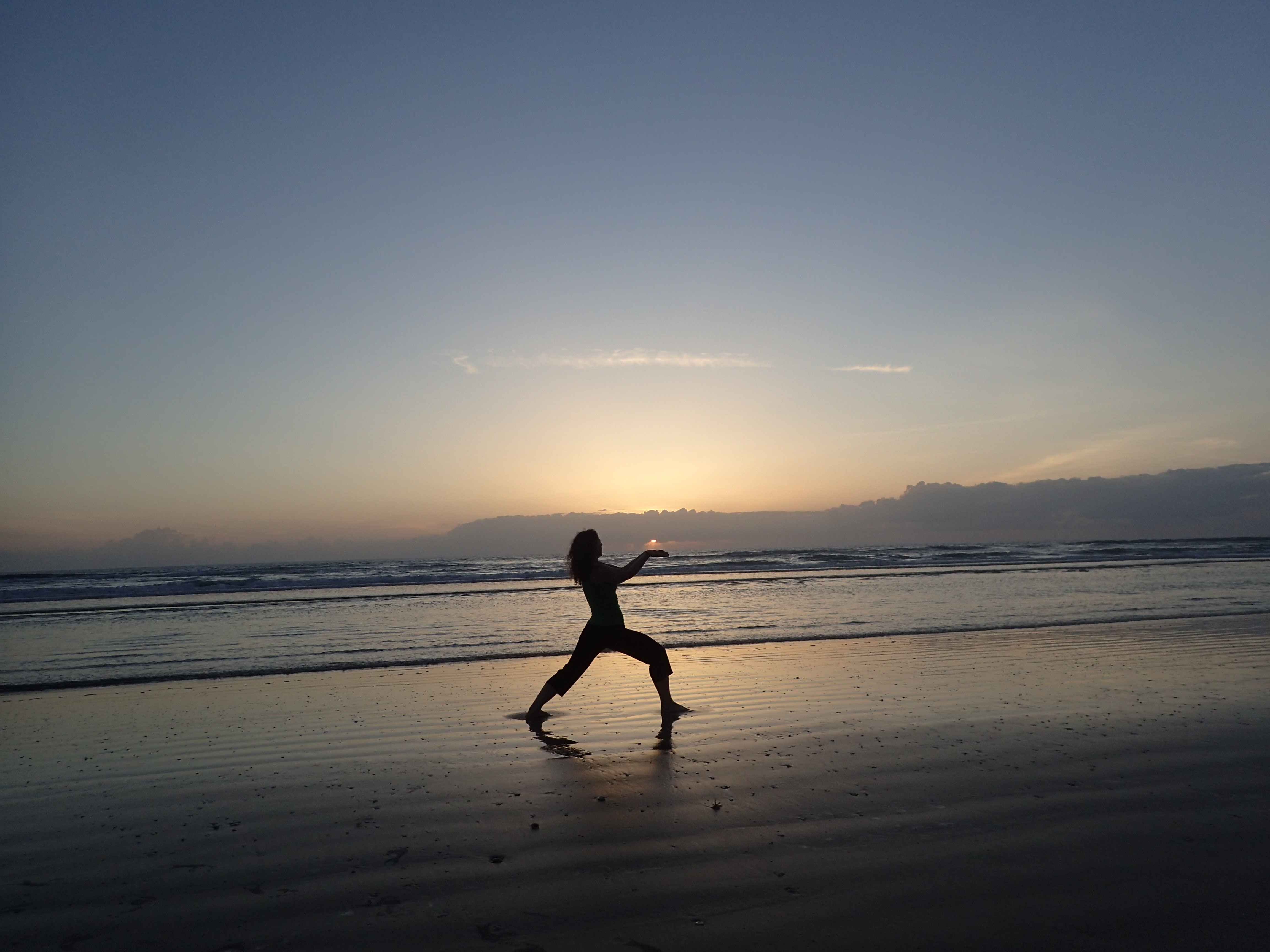Shradda
That which you hold in your heart.
Five ways to cultivate faith based on experience.
Sutra 1.20 speaks of how to nurture your spirit and your natural sense of oneness. For those of us not born enlightened, Sutra 1.20 lists 5 qualities that help us succeed in being in a constant state of awareness.
Sradda Virya Smrti Smadhi Prajnapurvaka Itaresam
This sutra begins with sradda (shraddha), faith.
One definition of shraddha is ‘that which you hold in your heart’. Shraddha is something you feel, not something you believe. Faith is something developed and cultivated through experience. When we experience something, we know it. We don’t need to believe in it. It simply is.
For most of us, our natural state of peace often remains elusive and we are caught up in the human experience along with its failures, triumphs, confusions, and epiphanies. When we are first starting out, it is especially easy to question and doubt in times of struggle and failure. As we are just beginning the journey, we don’t really have a sense of faith that we can feel, that we actually know.
This month’s full moon fruition is all about how to cultivate faith. Faith is most effective when it is focused on moving in the right direction, not on outright success in each attempt. We build faith that we will succeed in spending more and more of our time aware of the interconnectedness and bliss of it all.
It is key that our faith be based in the direction we are moving and not on the outcome. I believe this is a vital concept while cultivating faith. It is best to focus our attention on our successes in order to nurture an awareness that can withstand the trials and tribulations we put ourselves through. There will most likely be many failures, focus on the progress.
Five Practices to Cultivate Faith:
Breath
After practicing deep breathing exercises, most of us feel our mind calm and quiet a little. Note that we may still feel scattered, upset, or wound up, but it is helpful to observe the degree and intensity of these agitated states. Even one moment of calm or one magnitude less is success in the right direction. Experiencing some calming effect helps up develop faith because we begin to experience and know that a calmer states exists or that a moment of calm is possible. We are the ones who consciously directed our breath to help us feel peace and therefore we are capable of succeeding. At the very least, we are capable of something! The skill to quiet the mind grows and develops with practice like all skills.
Awareness
Note your successes! This is imperative to building faith. At one time I said that by the time I was 40, I wanted my work to revolve around me instead of me revolving around my work. I still work, and I work hard, but sometime after my 40th birthday I noticed that my work really was revolving around me! My plans and dreams have taken the driver’s seat and work opportunities conveniently fit into the empty spaces. I have a friend who is not especially spiritually inclined. This friend voiced that their ideal situation is being able walk to work and to build homes for vacationers that would rarely be around. At the time, no nearby property was for sale. Years later, a large parcel was subdivided and low and behold, several people paid my friend to build their vacation homes. My friend didn’t notice the correlation between their wishes and reality until I pointed it out. Notice when you voice something and it happens. Even little things. Notice when you wish for more time and an appointment is cancelled. The more you note, the more your faith will grow simply from watching it happen.
Perspective
Perspective helps immensely with faith in ourselves and in forgiving ourselves for all the times we fail. When we feel that we aren’t moving in the direction of peace, put it into perspective. Five years ago, how would we have reacted? Five years ago I may have put all the blame of an uncomfortable situation on someone else. Now I still may be moving from my ego, but my focus has shifted onto how I can improve and what I have contributed to the situation. I used to get snappy and unfocused at work around 2:00pm. Now I get snappy and unfocused at work at 1:55pm. That is 5 more minutes in a state of peace and 5 less minutes suffering and adding agitation to the world. Put all your trials and tribulations and successes into perspective. If I return to a negative habit, how long do I return to it before I snap out of it? How entrenched in the old habit do I become. For example, when I was quitting smoking, it took many many attempts. First I would quit for a short time and then relapse for a long time. Eventually, my relapses became shorter and shorter. Instead of picking up cigarettes for two months, it might be two weeks, then two days, and eventually two cigarettes before I stopped the habit. I was still ‘failing’ but not quite as intensely. When we put our successes and failures into perspective we build trust in ourselves. I stayed on the wagon for longer and got back on quicker. Of course some addictions and behaviors don’t have any leniency, but most of our habits that harm our spirits or our bodies do have some clemency if we allow ourselves to witness it. Put all failures and successes into perspective and it will nurture your faith in yourself and that you are moving in the right direction.
Sadhana
A sadhana is a spiritual practice that we commit to for a specific period of time. It is a commitment to doing something daily that moves us towards our natural state of peace. A sadhana can be as short as two minutes a day and is best practiced right when we wake up or right before we go to sleep. Examples of possible practices include: mindful breathing, meditation, singing, prayer, dancing, being still and quiet outside, admiring the beauty of a flower, loving kindness, a gratitude journal or anything else that helps you come into your natural best self and is practiced regularly.
Intention
We start developing our sadhana by thinking about our intention. Why are we practicing? Why would we like to move towards peace? Practice is always more effective when our intention is for something other than ourselves. This could mean that we want to be nicer to our families, we want to spread peace, we want to forgive, or anything more than only personal peace.
Duration
Choose a time period that challenges you but that also feels doable. When you begin, this may be as few as three days. Something is always better than nothing. Gradually, your faith in yourself will grow. If possible, I recommend beginning with 21, 30, or 40 days and eventually committing to a 90 day sadhana practice. The longer you choose to practice, the more the new focus becomes integrated into your being. As your practice lengthens, the focus and effects of your sadhana will wax and wane. Be patient and focus on the reason you are practicing. I assure you that there will be some level of increase in personal strength and faith.
Fasting
Fasting practices are only beneficial for healthy individuals who fast with a healthy intention and moderate their daily schedules to accommodate for any lack of energy. Fasting is not healthy as a means to control weight, invoke suffering, or any sense of control or punishment. I recommend individuals consult with a doctor before beginning their first fast. That being said, fasting has proved to be one the strongest faith builders for me. I return to it regularly when I feel the most lost. It is helpful to begin each fast with a conscious intention. Why are we fasting? Is it to clean the body, to quiet the mind, to build faith, to reset, to introspect, or simply to pause?
The easiest fast to begin with is from sunset to sunset. This form of fasting allows you to eat each day and still have the experience of watching sensations come and go, building will power, and letting focus rest more on mental and spiritual needs than on physical needs. You may find yourself absorbed the entire day in the sensation of being hungry. Not giving into the sensation still builds faith in yourself, faith in your ability to succeed.
The next stage of fasting is a full day. Eating one evening and then going to bed the next evening with no food. Three day fasts are said to be spiritually cleansing. As fasts get longer, if our bodies stop naturally excreting and releasing toxins, it may be important to incorporate some type of mild laxative tea or mixture to ensure toxins do not build up. As fasting times lengthen it also becomes more and more important to set time aside to doing little else but fasting. I often go about most normal day to day routines and can work while doing a sunset to sunset fast. However, I am sure to fast a full day on a weekend or when I have few responsibilities. Three day fasts are what I practice when I can put all of my life on hold.
To begin, choose one of these practices to cultivate faith then play with them all. What works best and benefits you most will change over time. Practice and we are sure to succeed.
That which you hold in your heart is that which you know, that which you have experienced.


